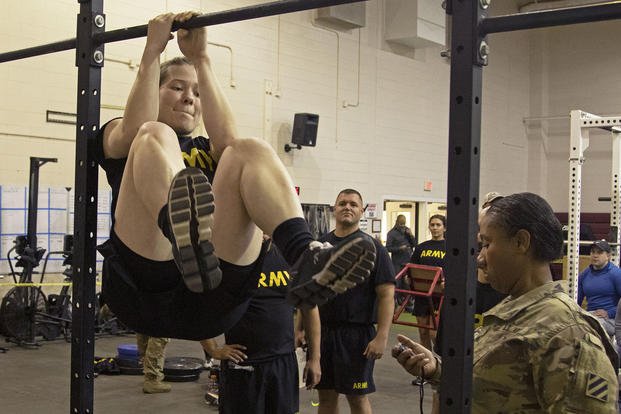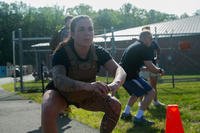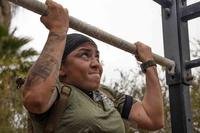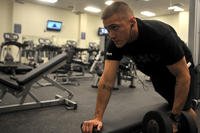If you are considering joining the Army this year or are currently employed by the Army, you will see a new fitness test by the end of the fiscal year (October 2019). In fact, many units have been testing it out this past year already.
Here's everything you need to know to excel at the new fitness test. If you are not used to lifting weights, you will. You will not have to do sit-ups, but the hanging knee-ups are no joke on the core and the grip. If you thought you might not have to run two miles -- well, you still have to do that, too. But there are some fun new exercises, too:
The new Army combat fitness test (ACFT) will replace the older Army physical fitness test (APFT), which originated in the early 1980s and included push-ups, sit-ups and a two-mile run. The new test is a result of the Army's identifying specific warrior tasks and battle drills (WTBD) that enhance a soldier's readiness on the battlefield. The comparison of the two tests are night and day; the tactical fitness elements tested with the ACFT will be muscular strength/power, cardiovascular endurance, muscle stamina, core strength/stamina and speed/agility.
The New ACFT
By October 2020, the ACFT will become fully implemented and will replace the APFT. The events are the following list:
1. Leg tuck: This is also known at the hanging knee-up. Hang from a pull-up bar using an alternating grip and bring your knees up to touch your elbows. No time limit -- just push yourself until you fail. You get max points if you can do 25. The minimum to pass is three.
2. Standing power throw: This is a backward toss with a 10-pound medicine ball, measured by how far your throw it behind you. The toss is measured in centimeters. The minimum standard is 450 cm (14.5 feet), and maxing the points requires a 1,400cm throw (45.9 feet).
3. Trap bar deadlift: Lift as much weight off the ground as you can three times, using the trap bar vs. a straight bar dead lift. The minimum lift is 170 pounds, and max points require a 400-pound deadlift three times.
4. Hand-release push-up: This is a completely different style of push-up. It also is called a four-count push-up, but the counts go like this: 1) up push-up, 2) down push-up, 3) extend arms to your side to form a T with the body, 4) bring arms back to down position of the push-up. Repeat for two minutes.
5. Shuttle sprint-drag-carry: This is essentially a shuttle run drill testing speed, agility and aerobic capacity while carrying a load a variety of ways:
- From the prone position, get up and sprint 25 meters and back to start with no weight.
- Pull a 90-pound sled 25m and back.
- Lateral run/sprint 25m and back with no weight.
- Grab two 45-pound kettlebells and run 25m and back.
- Forward run/sprint 25m and back with no weight.
The total distance of a 250-meter shuttle run is timed with a minimum standard of 2:40, and to receive maximum points you must get 1:30.
6. 2-mile run: The two-mile run is the same. However, the standards are the following: minimum (19:30), maximum (11:30).
Related video
Ideas to Implement These New Exercises
On your upper-body workout days, you should mix in leg tucks, power throws and hand-release push-ups into your programming. Some ideas:
- Warm up with hand-release push-ups
- Repeat five times.
- Jumping jacks 10
- HR push-ups 5-10
During a workout when working upper back and chest, mix in hand-release push-ups for a one-minute set. Similar exercises: reverse flies, birds, arm haulers
Consider the PT reset with HR push-ups in place of arm haulers as a cooldown cycle.
When doing pull-ups, pulldowns or an abdominal set, a logical place to add in leg tucks would be before a set of pulling exercises to challenge the grip, as two things will fail you with the leg tuck test: grip and abs/hips (core). If leg tucks are too tough, you can build up doing horizontal leg levers, bicycle crunches and vertical knee raises, until you can work your way to hanging knees ups on the pull-up bar.
Blend the New Exercises into a Classic PT Protocol
New PT pyramid workout: If you do not do pull-ups, you should practice mainly to get used to building your grip to hanging on the pull-up bar. Consider more commando grip (alternating grip) pull-ups, too.
- Pullups x1
- Hand-release push-ups x2
- Leg tucks x2
How far can you work up the pyramid and then repeat in reverse order? You always can end the workout with a two-mile run. Or mix intervals of half-mile tempo/paced runs every fifth set of the pyramid to maintain your two-mile run times. Check out the new Army CFT PT pyramid workout.
Leg Day Additions
Your leg days will be a great day to add in the following new exercises, such as the shuttle run, drag and carry test as well as the medicine ball throw and deadlift. If you are used to doing leg days, deadlifts likely will not be new to you, but adding in farmer walks, sled pulls and shuttle runs could be. A way to mix in them all into a challenging leg circuit would be the following:
- Repeat 3-4 times
- Cardio of choice 5 minutes (replace with shuttle/drag/carry 1-2 times during workout)
- Deadlift 5 reps
- Thrusters 5 reps (replace with medicine ball toss* -- 5 reps 1-2 times during workout)
*Note: The medicine-ball toss focuses its initial power from the legs when performing a squat to generate momentum, followed by a back extension and explosive arm to overhead movement. This blends well with most leg days, but it is essentially a full-body day.
Top It Off with Cardio
The two-mile run is here to stay. It is up to you how you want to improve or maintain your two-mile runs. You can follow the above workouts with a cooldown run of two or more miles or have cardio days between your lifting and PT days to focus solely on your running and/or rucking pace. If you need a non-impact day, replace your runs with bike, elliptical, rowing or swimming for safe but effective ways to work cardiovascular endurance.
Stew Smith is a former Navy SEAL and fitness author certified as a Strength and Conditioning Specialist (CSCS) with the National Strength and Conditioning Association. Visit his Fitness eBook store if you’re looking to start a workout program to create a healthy lifestyle. Send your fitness questions to stew@stewsmith.com.
Want to Learn More About Military Life?
Whether you're thinking of joining the military, looking for fitness and basic training tips, or keeping up with military life and benefits, Military.com has you covered. Subscribe to Military.com to have military news, updates and resources delivered directly to your inbox.




















